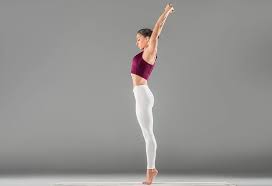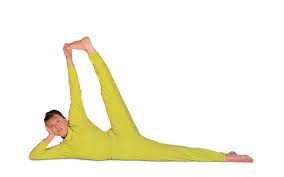Vatayanasana (Horse Pose)
Also called the Horse pose, it gets its name from the shape of the body, which resembles the face of a horse in this posture. You can also call it by its Sanskrit name, Vatayanasana. It is a classical Ashtanga Yoga pose. It basically looks like a combination of Garudasana and Ardha Padmasana. You need to have a considerable amount of flexibility, to be able to do this asana. So, it can be considered as an intermediate yoga pose.

How To Do It?
⦁ Stand in Samasthiti pose.
⦁ Then, you must slowly move into Ardha Badha Padmottanasana.
⦁ Keep your right leg in the half lotus pose and bring your hands on the mat. Jump backwards, while keeping the right leg in lotus, and move through the whole vinyasa sequence. You can also choose to start from downward dog pose, inhale and jump forward and lower the right knee down.
⦁ The left leg should be placed at a 90-degree angle.
⦁ In the meanwhile, you must practice ⦁ bandhas and straighten your back as well. Take the right arm under the left arm and wrap them both, around one another, just like in Garudasana. Stay there for five deep ⦁ ujjayi⦁ breaths. Move the hands as you exhale, and keep the right leg in lotus pose.
⦁ You can do the same thing, on the other side.
⦁ To come out of the posture, take a three-legged vinyasa pose, with you and jump forward. Take the left hand behind the back to bind it into Ardha Baddha Padmottanasana.
⦁ Slowly, inhale and release and come back to the Samasthiti pose, on exhale.
Benefits
⦁ If you practice this pose on a regular basis, your body will become extremely flexible. It also helps in releasing the trapped tension from the muscles.
⦁ In the long run, the endurance and stability of the bones and muscles, will also be enhanced.
⦁ This asana helps in the blood circulation to take place properly.
⦁ If you suffer from Arthritis, then this asana will definitely help you.
⦁ The main focus of the asana is on the lower body. The legs and hips are deeply involved the pose.
⦁ It can improve any sort of minor asymmetry of the body.
⦁ Your balance and concentration will also improve, with regular practice.
Contraindications
⦁ If you suffer from any condition, like Hernia or Sciatica, then you must not do the pose.
⦁ You must avoid it during pregnancy.
⦁ If you have an injured knee, hip, or ankle, then you must avoid this pose.
⦁ If you have Slip Disc, then you must not do this asana.
some of our courses :- 200 hour yoga teacher training in rishikesh , 300 hour yoga teacher training in rishikesh , yoga retreat in rishikesh





